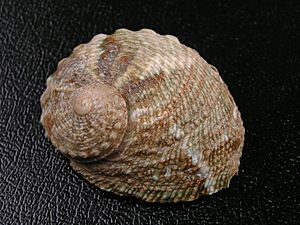Haliotis cyclobates facts for kids
Quick facts for kids Haliotis cyclobates |
|
|---|---|
 |
|
| Dorsal view of a shell of H. cyclobates | |
| Scientific classification | |
| Synonyms | |
|
Haliotis excavata Lamarck, 1822 |
The whirling abalone, also known as the circular ear shell, is a type of sea snail. Its scientific name is Haliotis cyclobates. It's a marine mollusk, which means it's an animal with a soft body, often protected by a shell. This snail belongs to the abalone family, called Haliotidae.
Contents
What Does the Whirling Abalone Look Like?
The shell of the whirling abalone can grow up to 60 millimeters (about 2.4 inches) long. It's almost round and looks a bit like a turban. The top part of the shell, called the apex, is set back from the edge.
Shell Shape and Texture
The main part of the shell, known as the body whorl, is rounded and curved on top. The surface of the shell has many spiral lines and ridges. It also has many folds that spread out from the suture, which is like a seam where the parts of the shell join.
The shell is very round and curved. The spire, which is the pointed top part, is quite raised and made of about three rounded sections called whorls. The last whorl has a dull ridge where the holes are. There's also a sharper, narrower ridge a little below it. The area between these two ridges is slightly curved inward.
Color and Inner Surface
The whole surface of the shell has close spiral lines and threads. Sometimes, these lines can feel a bit bumpy. The shell often has wide patches or stripes of different colors, like chestnut-brown, green, and a flesh-color or whitish.
The inside of the shell is shiny and silvery. It often shows beautiful red and green reflections. The spot where the snail's muscle attaches to the shell isn't very clear.
Breathing Holes
The whirling abalone usually has five oval-shaped holes. These holes are only slightly raised at their edges. These holes are important for the abalone to breathe and to release waste.
Where Does the Whirling Abalone Live?
This marine snail is endemic to Australia. This means it is found naturally only in Australia and nowhere else in the world. You can find the whirling abalone off the coasts of South Australia, Victoria, and Western Australia.

